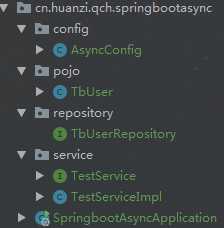SpringBoot系列——@Async优雅的异步调用
Posted huanzi-qch
tags:
篇首语:本文由小常识网(cha138.com)小编为大家整理,主要介绍了SpringBoot系列——@Async优雅的异步调用相关的知识,希望对你有一定的参考价值。
前言
众所周知,java的代码是同步顺序执行,当我们需要执行异步操作时我们需要创建一个新线程去执行,以往我们是这样操作的:
/** * 任务类 */ class Task implements Runnable @Override public void run() System.out.println(Thread.currentThread().getName() + ":异步任务");
//新建线程并执行任务类 new Thread(new Task()).start();
jdk1.8之后可以使用Lambda 表达式
//新建线程并执行任务类 new Thread(() -> System.out.println(Thread.currentThread().getName() + ":异步任务"); ).start();
当然,除了显式的new Thread,我们一般通过线程池获取线程,这里就不再展开
Spring 3.0之后提供了一个@Async注解,使用@Async注解进行优雅的异步调用,我们先看一下API对这个注解的定义:https://docs.spring.io/spring/docs/current/javadoc-api/org/springframework/scheduling/annotation/Async.html

本文记录在SpringBoot项目中使用@Async注解,实现优雅的异步调用
代码与测试
项目工程结构

因为要测试事务,所以需要引入
<!--添加springdata-jpa依赖 --> <dependency> <groupId>org.springframework.boot</groupId> <artifactId>spring-boot-starter-data-jpa</artifactId> </dependency> <!--添加mysql驱动依赖 --> <dependency> <groupId>mysql</groupId> <artifactId>mysql-connector-java</artifactId> </dependency>
在启动类开启启用异步调用,同时注入ApplicationRunner对象在启动类进行调用测试
package cn.huanzi.qch.springbootasync; import cn.huanzi.qch.springbootasync.service.TestService; import org.springframework.beans.factory.annotation.Autowired; import org.springframework.boot.ApplicationRunner; import org.springframework.boot.SpringApplication; import org.springframework.boot.autoconfigure.SpringBootApplication; import org.springframework.context.annotation.Bean; import org.springframework.scheduling.annotation.EnableAsync; import org.springframework.stereotype.Component; @Component @EnableAsync//开启异步调用 @SpringBootApplication public class SpringbootAsyncApplication @Autowired private TestService testService; public static void main(String[] args) SpringApplication.run(SpringbootAsyncApplication.class, args); /** * 启动成功 */ @Bean public ApplicationRunner applicationRunner() return applicationArguments -> long startTime = System.currentTimeMillis(); System.out.println(Thread.currentThread().getName() + ":开始调用异步业务"); //无返回值 // testService.asyncTask(); //有返回值,但主线程不需要用到返回值 // Future<String> future = testService.asyncTask("huanzi-qch"); //有返回值,且主线程需要用到返回值 // System.out.println(Thread.currentThread().getName() + ":返回值:" + testService.asyncTask("huanzi-qch").get()); //事务测试,事务正常提交 // testService.asyncTaskForTransaction(false); //事务测试,模拟异常事务回滚 // testService.asyncTaskForTransaction(true); long endTime = System.currentTimeMillis(); System.out.println(Thread.currentThread().getName() + ":调用异步业务结束,耗时:" + (endTime - startTime)); ;
看一下我们的测试业务类TestService
package cn.huanzi.qch.springbootasync.service; import java.util.concurrent.Future; public interface TestService /** * 异步调用,无返回值 */ void asyncTask(); /** * 异步调用,有返回值 */ Future<String> asyncTask(String s); /** * 异步调用,无返回值,事务测试 */ void asyncTaskForTransaction(Boolean exFlag);
package cn.huanzi.qch.springbootasync.service; import cn.huanzi.qch.springbootasync.pojo.TbUser; import cn.huanzi.qch.springbootasync.repository.TbUserRepository; import org.springframework.beans.factory.annotation.Autowired; import org.springframework.scheduling.annotation.Async; import org.springframework.scheduling.annotation.AsyncResult; import org.springframework.stereotype.Service; import org.springframework.transaction.annotation.Transactional; import java.util.concurrent.Future; @Service public class TestServiceImpl implements TestService @Autowired private TbUserRepository tbUserRepository; @Async @Override public void asyncTask() long startTime = System.currentTimeMillis(); try //模拟耗时 Thread.sleep(3000); catch (InterruptedException e) e.printStackTrace(); long endTime = System.currentTimeMillis(); System.out.println(Thread.currentThread().getName() + ":void asyncTask(),耗时:" + (endTime - startTime)); @Async("asyncTaskExecutor") @Override public Future<String> asyncTask(String s) long startTime = System.currentTimeMillis(); try //模拟耗时 Thread.sleep(3000); catch (InterruptedException e) e.printStackTrace(); long endTime = System.currentTimeMillis(); System.out.println(Thread.currentThread().getName() + ":Future<String> asyncTask(String s),耗时:" + (endTime - startTime)); return AsyncResult.forValue(s); @Async("asyncTaskExecutor") @Transactional @Override public void asyncTaskForTransaction(Boolean exFlag) //新增一个用户 TbUser tbUser = new TbUser(); tbUser.setUsername("huanzi-qch"); tbUser.setPassword("123456"); tbUserRepository.save(tbUser); if(exFlag) //模拟异常 throw new RuntimeException("模拟异常");
配置线程池
package cn.huanzi.qch.springbootasync.config; import org.springframework.context.annotation.Bean; import org.springframework.context.annotation.Configuration; import org.springframework.core.task.AsyncTaskExecutor; import org.springframework.scheduling.concurrent.ThreadPoolTaskExecutor; /** * 线程池的配置 */ @Configuration public class AsyncConfig private static final int MAX_POOL_SIZE = 50; private static final int CORE_POOL_SIZE = 20; @Bean("asyncTaskExecutor") public AsyncTaskExecutor asyncTaskExecutor() ThreadPoolTaskExecutor asyncTaskExecutor = new ThreadPoolTaskExecutor(); asyncTaskExecutor.setMaxPoolSize(MAX_POOL_SIZE); asyncTaskExecutor.setCorePoolSize(CORE_POOL_SIZE); asyncTaskExecutor.setThreadNamePrefix("async-task-thread-pool-"); asyncTaskExecutor.initialize(); return asyncTaskExecutor;
配置好后,@Async会默认从线程池获取线程,当然也可以显式的指定@Async("asyncTaskExecutor")
无返回值
/** * 启动成功 */ @Bean public ApplicationRunner applicationRunner() return applicationArguments -> long startTime = System.currentTimeMillis(); System.out.println(Thread.currentThread().getName() + ":开始调用异步业务");
//无返回值 testService.asyncTask();
long endTime = System.currentTimeMillis(); System.out.println(Thread.currentThread().getName() + ":调用异步业务结束,耗时:" + (endTime - startTime)); ;

有返回值
有返回值,但主线程不需要用到返回值
/** * 启动成功 */ @Bean public ApplicationRunner applicationRunner() return applicationArguments -> long startTime = System.currentTimeMillis(); System.out.println(Thread.currentThread().getName() + ":开始调用异步业务");//有返回值,但主线程不需要用到返回值 Future<String> future = testService.asyncTask("huanzi-qch"); long endTime = System.currentTimeMillis(); System.out.println(Thread.currentThread().getName() + ":调用异步业务结束,耗时:" + (endTime - startTime)); ;

有返回值,且主线程需要用到返回值
/** * 启动成功 */ @Bean public ApplicationRunner applicationRunner() return applicationArguments -> long startTime = System.currentTimeMillis(); System.out.println(Thread.currentThread().getName() + ":开始调用异步业务"); //有返回值,且主线程需要用到返回值 System.out.println(Thread.currentThread().getName() + ":返回值:" + testService.asyncTask("huanzi-qch").get()); long endTime = System.currentTimeMillis(); System.out.println(Thread.currentThread().getName() + ":调用异步业务结束,耗时:" + (endTime - startTime)); ;

可以发现,有返回值的情况下,虽然异步业务逻辑是由新线程执行,但如果在主线程操作返回值对象,主线程会等待,还是顺序执行
事务测试
为了方便观察、测试,我们在配置文件中将日志级别设置成debug
#修改日志登记,方便调试
logging.level.root=debug
事务提交
/** * 启动成功 */ @Bean public ApplicationRunner applicationRunner() return applicationArguments -> long startTime = System.currentTimeMillis(); System.out.println(Thread.currentThread().getName() + ":开始调用异步业务");//事务测试,事务正常提交 testService.asyncTaskForTransaction(false); long endTime = System.currentTimeMillis(); System.out.println(Thread.currentThread().getName() + ":调用异步业务结束,耗时:" + (endTime - startTime)); ;



模拟异常,事务回滚
/** * 启动成功 */ @Bean public ApplicationRunner applicationRunner() return applicationArguments -> long startTime = System.currentTimeMillis(); System.out.println(Thread.currentThread().getName() + ":开始调用异步业务"); //事务测试,模拟异常事务回滚 testService.asyncTaskForTransaction(true); long endTime = System.currentTimeMillis(); System.out.println(Thread.currentThread().getName() + ":调用异步业务结束,耗时:" + (endTime - startTime)); ;



后记
SpringBoot使用@Async优雅的异步调用就暂时记录到这里,以后再进行补充
代码开源
代码已经开源、托管到我的GitHub、码云:
GitHub:https://github.com/huanzi-qch/springBoot
码云:https://gitee.com/huanzi-qch/springBoot
以上是关于SpringBoot系列——@Async优雅的异步调用的主要内容,如果未能解决你的问题,请参考以下文章